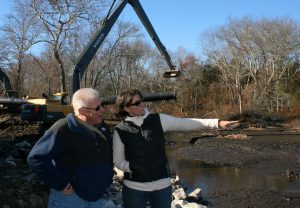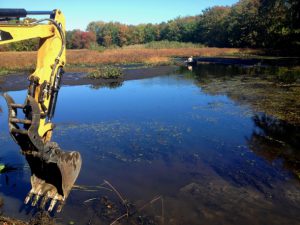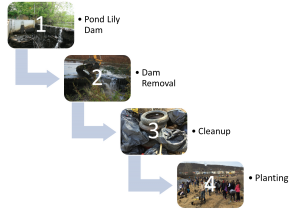The rivers and streams of Long Island Sound watershed are home to more than 5,000 dams, many of which no longer provide economic benefit and have fallen into disrepair. These derelict structures pose flood risks to nearby communities and keep migratory fish from reaching their native spawning grounds, disrupting local ecosystems and the Long Island Sound food chain. Removing outdated dams can resolve practical concerns like landowner liability, while improving water quality and restoring fragmented ecosystems.
Since 2015, Save the Sound’s Ecological Restoration team has removed dams on the West River in New Haven, Whitford Brook in Mystic, and the Quinnipiac River in Meriden and Southington, freeing over 23 river miles for migratory fish to swim upstream and safely spawn. Where dam removal isn’t possible or other obstacles block fish passage, the team improves migration by building fishways and retrofiting culverts, like the Bride Brook culvert at Rocky Neck State Park and the Noroton River fishway on the Stamford-Darien border.
See these projects and others in action on our Videos page.
Currently, the team is removing Dana Dam, aka Strong Pond Dam, at Merwin Meadows Park in Wilton, CT. Construction began in the summer of 2023 with final dam removal planned for September. Removing this dam will reconnect 14 miles of free-flowing river, allowing migratory and resident fish to reach ideal feeding and breeding grounds in the Norwalk River.
It’s partnerships that make these projects possible. By working closely with federal, state, and municipal officials, public and private community organizations, local engineering and building companies, landowners, and concerned citizens, we restore river access for Alewife, Blueback Herring, American Eel, and other migratory fish.
Now, Save the Sound has joined with Housatonic Valley Association, Farmington River Watershed Association, Trout Unlimited, Connecticut River Conservancy, American Rivers, Seatuck Environmental Association, and The Nature Conservancy in Connecticut as part of the Long Island Sound River Restoration Network, working collaboratively to free our region’s rivers. Get in touch with members of the network if you know of a dam that is no longer serving a purpose, posing risks to the community or ecosystem, or is at risk of breaching. Our combined decades of experience will guide us through developing the best restoration plans for each barrier.
And the work doesn’t stop there. Save the Sound takes a comprehensive approach to dam removal by restoring natural habitat surrounding the river that offers critical shelter and feeding areas for fish and other animals.
Community events like cleanups, streamwalks, and plantings ensure the river’s neighbors understand the changes in their backyards and get a first-hand look at restoration in action. Watch a video of a restoration planting and click here to learn how you can become a river restoration volunteer!



